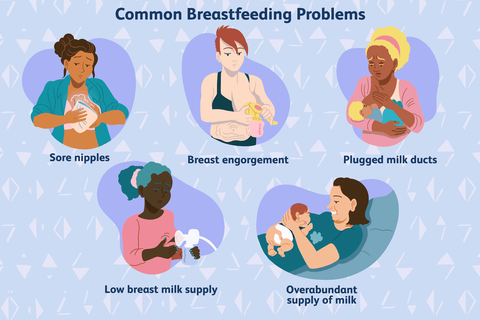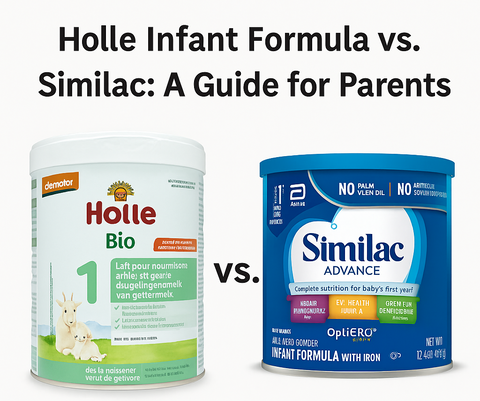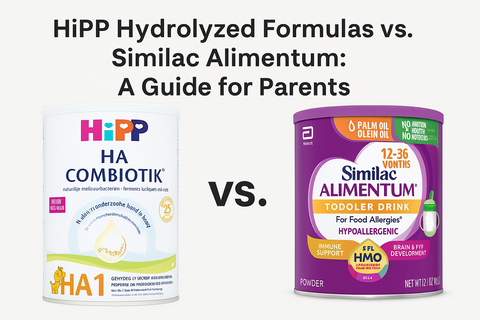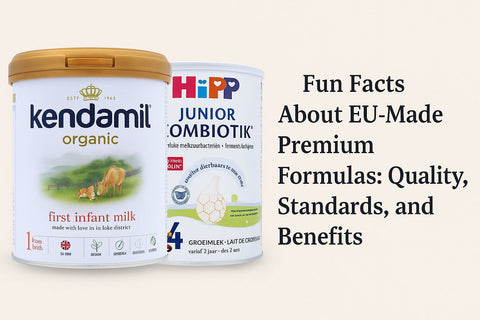A Natural Remedy: Using Cabbage Leaves during Breastfeeding and Weaning
The journey of motherhood is often described as a beautiful and rewarding experience. But it's important to acknowledge that it can come with its fair share of challenges. One of these challenges faced by many new mothers is breastfeeding difficulties. Cracked and/or bleeding nipples, painful bouts of mastitis, and engorged breasts can be overwhelming and distressing. While these challenges can feel daunting, it's comforting to know that various home remedies, including the use of cabbage leaves, can provide relief. In this article, you will learn more about the effectiveness of this home remedy.
Understanding Breast Pain During Breastfeeding
Breast pain is a common complaint among breastfeeding women, often experienced in various forms. Understanding the underlying causes of breast pain is essential to addressing the issue effectively.

Common reasons for breast pain during breastfeeding include:
Breast Engorgement: Engorgement occurs due to an excessive build-up of milk in the breasts, leading to firm, painful, and swollen breasts. Engorgement can happen in the early days of breastfeeding as the milk supply establishes itself or if the breasts are not adequately drained during feeding.
Blocked Milk Ducts: Nursing mothers may encounter blocked or clogged milk ducts, hindering the smooth flow of breast milk. This can result in localized pain, tenderness, and a small lump in the breast.
Mastitis: Mastitis is a breast infection that can develop when bacteria enter the breast tissue, often through cracked nipples. Symptoms include breast inflammation, soreness, redness, and flu-like symptoms. Prompt medical attention and antibiotics are usually required for mastitis treatment. A scientific study showed that cabbage leaf treatment used on women with breast engorgement reduced pain, and the engorged breasts' hardness increased the duration of breastfeeding.
Improper Latch or Positioning: An incorrect latch or suboptimal breastfeeding position can lead to nipple soreness, discomfort, and breast pain.
Hormonal Changes: Hormonal fluctuations during breastfeeding can make breast tissue more sensitive and tender, contributing to breast pain.
Now, let's delve deeper into how cabbage leaves can be used to address these breastfeeding issues.
Using Cabbage Leaves for Breast Pain Relief

The steps to use cabbage leaves as a remedy for breast pain are straightforward, and they can be applied in cases of engorgement, mastitis or when seeking relief during the weaning process:
Select Fresh Cabbage Leaves: Choose fresh, green cabbage leaves for optimal results. Organic cabbage is preferable, but thoroughly washing conventional cabbage can help remove surface contaminants.
Clean the Leaves: Wash the cabbage leaves thoroughly to eliminate dirt and impurities. Gently pat them dry with a clean towel.
Prepare the Leaves: Take one or two cabbage leaves and remove the hard central rib by cutting it out or making a small V-shaped notch in the leaf.
Apply the Cabbage Leaves: Place the cabbage leaves directly on your breasts, covering the area experiencing pain. If your nipples are sore, cracked, or bleeding, it's advisable to leave them exposed. A lanolin cream can be used to soothe sore nipples.
Timing: Leave the cabbage leaves on your breasts for approximately 20 to 30 minutes or until you experience relief.
Post-Treatment: After removing the cabbage leaves, wash your breasts with warm water to remove any residue or odor from the cabbage.
These steps outline the application of cabbage leaves to alleviate breast pain. While this method can provide relief, it's essential to acknowledge its limitations and potential side effects.
Using Cabbage Leaves for Weaning
Breastfeeding is a personal journey. There are various reasons a mother might choose to wean her child, whether gradually or more rapidly. Cabbage leaves can be a helpful tool for those who want to expedite the weaning process.
If you are using cabbage leaves while weaning, you can follow the same steps above but leave the cabbage on your breasts until it wilts, then apply new leaves as often as needed for comfort.
In addition, if you're weaning, avoid any form of nipple stimulation (but if you're feeling severe discomfort, hand express a small amount of milk for relief), wear a well-fitting and supportive bra, apply ice packs or frozen vegetables to throbbing breasts, and take a pain reliever like acetaminophen or ibuprofen.
It's important to emphasize that cabbage leaves alone may not guarantee a rapid reduction in milk supply during the weaning process. While they can be a supportive measure, the timeframe for weaning varies from person to person.
The Science Behind Cabbage Leaves and Breastfeeding
Now that we've discussed how to use cabbage leaves, you might be curious about the science behind this technique.
Using cabbage leaves as a remedy might sound unconventional, but midwives and lactation consultants have employed it for decades. The scientific basis for this remedy lies in the unique properties of cabbage leaves. Cabbage contains certain compounds, such as flavonoids and glycosylates, with anti-inflammatory and analgesic (pain-relieving) properties. When applied, these compounds are believed to help reduce inflammation and relieve breast pain. Additionally, cabbage leaves' coolness and moisture-absorbing properties may provide a soothing effect, particularly for engorged breasts.
In a 2021 scientific study, “The Effect of Cabbage Leaves Compress on Breast Engorgement in Postpartum Mother,” researchers focused on knowing how cabbage leaf compression affects breast engorgement in postpartum mothers.
RESULTS: The majority of the characteristics of respondents who experience breast engorgement are postpartum mothers aged 20–35 years with all different backgrounds. Before cabbage leaves compression, the majority of 29 mothers (96.7%) experienced engorgement on a scale of 3 and declined to a scale of 2 after the intervention.
CONCLUSION: Cabbage leaf compression has a significant effect on breast engorgement for postpartum mothers.
Regarding reducing milk supply, cabbage leaves are thought to exert a mild "drying" effect on the breasts. The pressure and coolness of the leaves may help temporarily decrease blood flow and milk production. However, it's crucial to approach cabbage leaf treatment cautiously and consider it a complementary or supportive measure rather than a standalone solution. Consulting with a healthcare professional or lactation consultant is advisable for personalized guidance and addressing underlying breastfeeding concerns.
The Myth of Gassy Foods and Cabbage
One concern often arises when discussing cabbage and breastfeeding is the myth of gassy foods. As a cruciferous vegetable, Cabbage has been mistakenly associated with making both mothers and their babies gassy. This belief has led some healthcare providers to advise breastfeeding women to avoid cabbage to prevent their infants from experiencing discomfort due to increased gas.
However, scientific evidence contradicts this myth. Research suggests that gas and fiber in a mother's diet do not pass into breast milk, debunking the idea that gassy foods the mother consumes cause gassiness in the baby. In reality, cabbage, while often seen as unimpressive, is rich in essential nutrients such as vitamins K and C and folate, which can contribute to a mother's overall health during breastfeeding.
Safety Considerations 
While cabbage leaf treatment is generally regarded as safe and relatively risk-free, a few mild safety considerations should be kept in mind:
Decreased Milk Supply: If you are using cabbage leaves to relieve pain while still breastfeeding, there is a possibility that your milk supply might decrease. This can be particularly concerning if you exclusively breastfeed. To minimize this risk, remove the cabbage leaves as soon as you experience relief and limit the frequency of use.
Possible Side Effects: Some individuals may be allergic to cabbage or experience skin irritation or sensitivity. If you have a known cabbage allergy or notice any redness, itching, or discomfort after applying cabbage leaves, remove them immediately and discontinue use.
Infections: It's essential to understand that while cabbage leaves can provide relief for symptoms, they do not serve as a cure for infections. Suppose you suspect you have an infection, such as mastitis, and are experiencing symptoms like fever, chills, or body aches. In that case, contacting your healthcare provider immediately is crucial for prompt medical attention.
When to Seek Professional Guidance?
Cabbage leaves, while a valuable tool for addressing particular breastfeeding challenges, may not be a one-size-fits-all solution. If you find that cabbage leaves do not alleviate your breastfeeding woes or if your symptoms persist or worsen, please get in touch with your healthcare provider. This is especially crucial if you suspect you have mastitis and experience symptoms like fever, chills, or body aches.
In conclusion
The journey of breastfeeding comes with its unique set of challenges. While these challenges can be overwhelming, it's comforting to know that simple and natural remedies, such as cabbage leaves, are available. Whether you're dealing with engorgement, mastitis, or the weaning process, cabbage leaves can be a cost-effective and accessible solution. The experiences of countless mothers and the comfort they have found through this practice are a testament to its potential effectiveness.
In the end, breastfeeding is a personal journey, and there's no one-size-fits-all approach. The most crucial aspect is the well-being of the mother and the baby and finding solutions that work best for your unique situation.
So, embrace the wisdom passed down through generations of mothers and consider giving cabbage leaves a try when facing breastfeeding discomfort. Your journey as a mother is a testament to strength, resilience, and the enduring power of a mother's love. Remember, you're not alone on this path; a world of support and knowledge is available to help you along the way.
As you navigate the intricacies of breastfeeding, remember that support and guidance from healthcare professionals and lactation consultants are always available to address your specific concerns.
Contact
Contact our dedicated customer support team for expert advice and guidance tailored to your baby's needs. Our customer success team has earned hundreds of 5-star reviews from customers dedicated to helping you provide the best nutrition for your little one. Contact us here or shoot us an email at support@organicformulashop.com. We're here to help!
Happy Feeding!
Disclaimer: This information is based on general trends in breastfeeding and nutrition. It is not medical advice. Always consult your healthcare provider for personalized guidance on your breastfeeding journey.




